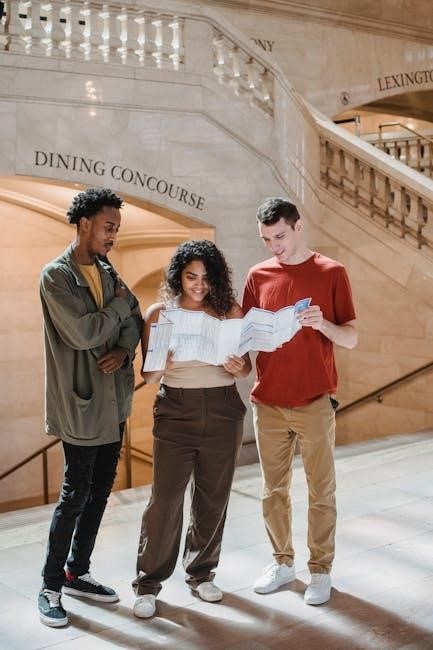Manila, the vibrant capital of the Philippines, offers a rich blend of history, culture, and modern attractions, making it a must-visit destination for any traveler.
1.1 Why Manila is a Must-Visit Destination
Manila captivates visitors with its rich history, vibrant culture, and modern attractions, offering a unique blend of old and new. Explore historic sites like Intramuros and Fort Santiago, which showcase the city’s colonial past. The city’s cultural diversity, influenced by Spanish, American, Chinese, and Malay traditions, creates a fascinating experience through its food, festivals, and customs. Manila’s dynamic nightlife, featuring top bars and clubs in areas like Makati, appeals to those who enjoy evening adventures. Additionally, the city boasts world-class shopping malls and bustling local markets, providing endless opportunities for retail therapy. Nature enthusiasts can escape to nearby beaches and natural wonders, such as Pagsanjan Falls, making Manila a versatile destination for all interests. With its diverse offerings, Manila promises an unforgettable journey for every traveler.
1.2 Best Time to Visit Manila
The best time to visit Manila is during the dry season, from December to May, when the weather is cooler and less humid. The ‘-ber months’ (September to November) are particularly festive, with Christmas lights and decorations transforming the city. Avoid the rainy season, from June to October, to ensure a more comfortable travel experience. Plan your trip during these months to enjoy Manila’s vibrant culture, historical sites, and modern attractions without the inconvenience of heavy rainfall. This period is ideal for exploring Intramuros, attending festivals, and experiencing the city’s lively atmosphere.

Historical and Cultural Significance of Manila
Manila, the Philippines’ capital, is a melting pot of Spanish, American, and Asian influences, offering a rich historical tapestry and vibrant cultural experiences that captivate visitors worldwide.
2.1 Key Historical Events That Shaped Manila
Manila’s history is a tapestry of colonial rule and resilience. The Spanish established Intramuros in 1571, making it the walled city and the seat of power. The Manila Galleons connected the Philippines to Mexico, boosting trade. The Philippine Revolution of 1896 sparked independence movements. World War II devastated the city, but it rose again. These events shaped Manila’s identity as a resilient, culturally rich metropolis.
2.2 Manila as a Cultural Melting Pot
Manila is a vibrant example of cultural diversity, blending Spanish, American, Chinese, and Malay influences. The city’s festivals, cuisine, and architecture reflect this rich heritage. From the grand Manila Carnival to the bustling streets of Binondo, Asia’s oldest Chinatown, Manila celebrates its multicultural identity. The mix of Spanish-era churches, Art Deco buildings, and modern skyscrapers showcases its dynamic history. The city’s food scene, featuring dishes like adobo and lumpia, further highlights its cultural fusion. Manila’s arts and music scene, with venues like the Manila Metropolitan Theatre, also thrive, making it a hub of creative expression and cultural exchange.

Top Cultural Attractions in Manila
Manila boasts a rich tapestry of cultural landmarks, museums, and historical sites, offering a glimpse into its vibrant past and diverse heritage.
3.1 Intramuros: The Walled City
Intramuros, Manila’s historic walled city, is a testament to the Philippines’ rich colonial past. This iconic district, established by Spanish conquistadors in 1571, features cobblestone streets, ancient churches, and historic fortifications. Visitors can explore Fort Santiago, a former military outpost, and the San Agustin Church, a UNESCO World Heritage Site. Intramuros also offers a glimpse into Manila’s resilience, having survived wars and natural disasters. Guided tours, including horse-drawn carriage rides, provide a deeper understanding of its significance. Today, it stands as a cultural and historical gem, attracting locals and tourists alike to experience the city’s enduring legacy.
3.2 Fort Santiago and Its Historical Importance
Fort Santiago, a pivotal landmark within Intramuros, stands as a testament to Manila’s complex history. Built by Spanish conquistadors in 1571, the fort served as a military outpost and later as a prison during the Spanish and American colonial periods. It is most famously known as the detention site of Philippine national hero José Rizal before his execution in 1896. The fort’s architecture reflects its strategic importance, with sturdy stone walls and bastions. Today, it houses a museum and the Rizal Shrine, offering insight into the nation’s struggle for independence. Fort Santiago is a poignant reminder of Manila’s resilience and its role in shaping the Philippines’ identity.
3.3 San Agustin Church and Museum
San Agustin Church, a UNESCO World Heritage Site, is one of the oldest and most stunning churches in the Philippines. Completed in 1607, it showcases Baroque architecture with its ornate interiors and trompe l’oeil ceilings. The adjacent San Agustin Museum houses centuries-old religious artifacts, paintings, and historical relics, offering a glimpse into Manila’s colonial past. Visitors can explore the crypt where Spanish friars and notable Filipinos are buried. This iconic landmark is a must-visit for history enthusiasts and those seeking to understand the cultural and religious heritage of Manila. Its enduring beauty and historical significance make it a cornerstone of Intramuros.

Practical Travel Information
Plan your trip to Manila with essential insights on visas, vaccinations, and weather. Best months to visit are September to November for a festive atmosphere and cooler climate.
4.1 How to Get to Manila
Manila is easily accessible by air, with Ninoy Aquino International Airport (NAIA) serving as the primary gateway. Direct flights from major cities like Dubai, Singapore, and Hong Kong are available. Philippine Airlines and Cebu Pacific offer frequent services. Travelers can also arrive by sea, though air travel is more convenient. The best time to book flights is during off-peak seasons for better fares. Upon arrival, taxis, ride-hailing apps, and public transport are readily available. Pre-booking airport transfers is recommended for a hassle-free journey. For international travelers, ensure all visa requirements are met before departure. Plan ahead to avoid peak holiday seasons for smoother travel.
4.2 Getting Around Manila: Transportation Options
Manila offers a variety of transportation options to suit different needs and budgets. The Light Rail Transit (LRT) and Metro Rail Transit (MRT) are efficient ways to navigate the city, with routes covering major areas like Makati and Quezon City. Jeepneys and buses are affordable and widely available, while taxis and ride-hailing apps like Grab provide convenience. For shorter distances, tricycles and pedicabs are ideal. The Ninoy Aquino International Airport (NAIA) is well-connected, with taxis and private cars readily accessible. Be prepared for traffic, especially during peak hours. Plan your route in advance and consider using apps for real-time updates. Walking is also feasible in smaller districts like Intramuros and Bonifacio Global City (BGC).
4.3 Essential Travel Requirements and Documents
Travelers visiting Manila must ensure they have all necessary documents. A valid passport with at least six months’ validity is required for entry. Depending on your nationality, a visa may be needed; check the Philippine government’s visa policies. Health certificates, such as COVID-19 vaccination proof, may be required. Travel insurance is highly recommended to cover unexpected medical or travel-related issues. Carry photocopies of your passport, visa, and travel insurance, and keep digital copies secure. Research any specific entry requirements, such as health declarations or quarantine rules, before your trip. Ensuring all documents are in order will help make your journey to Manila smooth and stress-free.
Best Accommodation Options in Manila
Manila offers diverse lodging choices, from luxury hotels to budget-friendly guesthouses, catering to all travelers’ needs and preferences, ensuring a comfortable stay in this vibrant city.
5.1 Luxury Hotels in Manila
Manila boasts an array of luxurious hotels offering world-class amenities and unparalleled service. The Ritz-Carlton, Manila, and the Shangri-La at the Fort are top choices, featuring upscale dining, rooftop pools, and spas. These hotels cater to discerning travelers, providing sleek, modern accommodations in prime locations like Makati and Bonifacio Global City. Many luxury hotels offer stunning views of the city skyline or Manila Bay, while others are nestled near cultural landmarks. Guests can enjoy fine dining, exclusive lounges, and state-of-the-art fitness centers. Whether for business or leisure, Manila’s luxury hotels promise a sophisticated and memorable stay, blending comfort with timeless elegance.
5.2 Mid-Range Hotels for Budget Travelers
Manila offers a variety of mid-range hotels that cater to budget travelers seeking comfort without excessive costs. Hotels like the Berjaya Makati Hotel and the Red Planet Manila Bay provide cozy rooms, essential amenities, and convenient locations. Many of these hotels are situated in bustling areas such as Makati and Quezon City, offering easy access to public transport, shopping, and dining options. They often feature free Wi-Fi, breakfast options, and clean, well-maintained facilities. These mid-range accommodations are ideal for travelers who want to explore Manila’s vibrant culture and attractions while staying within their budget. They strike a perfect balance between affordability and quality.
5.3 Budget-Friendly Hostels and Guesthouses
Manila offers a variety of budget-friendly hostels and guesthouses perfect for travelers seeking affordable yet comfortable accommodations. Options like the Mad Monkey Hostel and Selah Pods Hotel & Suites provide cozy dormitories and private rooms at budget-friendly rates. Many of these establishments are centrally located in areas such as Makati, Pasay, and Bonifacio Global City, offering easy access to key attractions. They often feature shared lounges, free Wi-Fi, and basic amenities, creating a social atmosphere for guests. These hostels are ideal for solo travelers and backpackers looking to explore Manila without breaking the bank. They offer a great balance of affordability and convenience.
Dining in Manila: A Food Lover’s Guide
Manila offers a diverse culinary scene, blending traditional Filipino flavors with international cuisines, ensuring a delightful experience for every food enthusiast. Explore street food, local eateries, and fine dining options.
6.1 Must-Try Street Food in Manila
Manila’s street food scene is a culinary paradise, offering a variety of affordable and delicious dishes. Sisig, a sizzling plate of chopped pork face, is a must-try, while adobo, a flavorful stew, showcases Filipino culinary expertise. Lechon, a whole roasted pig, is a festive favorite. Sinigang, a sour soup, and balut, a fertilized duck egg, are iconic street food options. These dishes reflect Manila’s rich cultural heritage and vibrant food traditions, making every bite a memorable experience for visitors. Exploring street food is a great way to immerse yourself in the city’s dynamic and flavorful culture.
6.2 Best Restaurants for a Unique Dining Experience
Manila boasts a diverse dining scene with restaurants offering unforgettable experiences. Antonio’s Garden, nestled in a lush garden, provides a romantic ambiance perfect for special occasions. Barbara’s Heritage Restaurant, located in Intramuros, serves traditional Filipino cuisine in a historic setting. For a luxurious experience, Spiral at Sofitel offers a vast buffet with international and local dishes. These restaurants combine exceptional food with unique atmospheres, making them must-visit spots for a memorable dining experience in Manila. Each establishment reflects the city’s rich cultural tapestry, ensuring a delightful culinary journey for all visitors.
6.3 Popular Local Dishes to Try
Manila’s culinary scene offers a vibrant mix of flavors, reflecting the city’s rich cultural heritage. Adobo, a classic Filipino dish, is a must-try, featuring marinated meat or seafood in a savory vinegar-based sauce. Sinigang, a sour soup with fresh vegetables and proteins, is another staple. For a festive treat, lechon, a whole roasted pig, is a showstopper. Street food enthusiasts will love balut, a developing duck embryo boiled and eaten from the shell, and kwek-kwek, quail eggs coated in orange batter. These dishes, along with the city’s famous hospitality, promise a memorable and authentic dining experience in Manila.

Shopping in Manila
Manila offers a diverse shopping experience, from high-end malls to vibrant street markets, perfect for finding unique souvenirs, local crafts, and affordable fashion.
7.1 Best Shopping Malls in Metro Manila
Metro Manila is a shopper’s paradise, featuring world-class shopping malls that cater to diverse preferences. Greenbelt in Makati is renowned for its luxury brands and serene garden setting. Ayala Malls, such as Ayala Center and Bonifacio High Street, offer a mix of high-end and affordable options. SM Mall of Asia in Pasay is a favorite for family-friendly shopping and entertainment. Glorietta and Landmark in Makati provide a wide range of retail choices. Robinsons Place Manila and SM City North EDSA are popular for their extensive selections and budget-friendly options. These malls offer a vibrant shopping experience, blending style, convenience, and entertainment.
7.2 Bargain Hunting at Local Markets
Manila’s local markets offer a vibrant shopping experience for bargain hunters. Divisoria is a top destination for affordable goods, from clothing to household items. Binondo, the world’s oldest Chinatown, is perfect for finding unique souvenirs and authentic Chinese products. Mercato Centrale in Bonifacio Global City features a variety of artisanal goods and street food. These markets provide a chance to practice haggling and immerse yourself in the local culture. With their lively atmosphere and diverse offerings, Manila’s markets are a must-visit for anyone seeking budget-friendly shopping and a taste of the city’s authentic charm. They cater to all kinds of shoppers, ensuring a memorable experience.
7.3 Unique Souvenir Shops
Manila offers a variety of unique souvenir shops where you can find authentic Filipino items. Kultura Filipino is a top choice, showcasing traditional crafts, clothing, and home decor. Tesoro’s, located in Intramuros, specializes in Filipino-designed souvenirs, perfect for memorable gifts. For a luxurious shopping experience, Solaire Resort & Casino features high-end boutiques offering exclusive Filipino products. Additionally, local markets like Mercato Centrale provide handmade crafts and artisanal goods. These shops offer a blend of tradition and modernity, allowing visitors to take a piece of Manila’s culture home. Whether you’re looking for something elegant or quirky, Manila’s souvenir shops cater to every taste and budget.

Nightlife in Manila
Manila’s vibrant nightlife offers a cosmopolitan mix of rooftop bars, live music venues, and lively clubs, perfect for every mood and preference, day or night.
8.1 Top Bars and Rooftop Lounges
Manila’s nightlife shines with its top bars and rooftop lounges, offering stunning views and vibrant atmospheres. Popular spots like Antidote and The Penthouse provide craft cocktails and live music, while others, such as The Roofdeck, feature chic settings perfect for unwinding. These venues cater to diverse tastes, from cozy corners for intimate gatherings to lively spaces for dancing. Many bars also serve local spirits and innovative mixes, blending Filipino flavors with global trends. Whether you’re looking for a relaxed evening or an energetic night out, Manila’s rooftop bars and lounges promise unforgettable experiences with their unique charm and cosmopolitan vibe.
8.2 Best Nightclubs for Dancing
Manila’s nightlife pulsates with energetic nightclubs perfect for dancing enthusiasts. Clubs like The Palace Pool Club and Republiq offer vibrant atmospheres with top DJs spinning diverse music genres. These venues are known for their state-of-the-art sound systems and lively crowds, creating unforgettable experiences. Many clubs feature themed nights, from hip-hop to electronic dance music, catering to all tastes. Located in areas like Bonifacio Global City and Makati, they attract both locals and tourists. Dress codes and early arrivals are recommended for a smooth entry. Whether you’re a seasoned clubber or a first-timer, Manila’s nightclubs promise an electrifying way to dance the night away in style.
8.3 Live Music Venues
Manila’s live music scene thrives in venues that cater to diverse tastes. 19 East is a favorite for intimate gigs, showcasing local and indie artists in a cozy setting. Music Museum hosts a variety of acts, from rock bands to acoustic performances, while The Shed offers a unique outdoor experience with live bands and a lively atmosphere. For jazz enthusiasts, The Jazz Hive is a must-visit, featuring soulful performances by both established and emerging artists. These venues provide a platform for Manila’s vibrant music culture, making them essential stops for any music lover visiting the city.
Day Trips from Manila
Explore nearby destinations like Mount Pinatubo, White Rock Beach, and Subic for adventure, relaxation, and natural beauty, offering a perfect escape from the city’s hustle.
9.1 Exploring Nearby Beaches
Manila offers easy access to stunning beaches perfect for day trips. White Rock Beach in Zambales, known for its pristine shores and crystal-clear waters, is a top choice. Visitors can enjoy swimming, snorkeling, or simply relaxing under palm trees. Subic Bay, another nearby destination, features beautiful beaches with vibrant marine life, ideal for scuba diving and water sports. These beaches provide a refreshing escape from the city, offering a mix of adventure and relaxation. Plan your trip early, considering travel time and local conditions, to make the most of your beach adventure near Manila.
9.2 Historical Day Trips
Embark on a journey through time with historical day trips from Manila. Visit Pagsanjan Falls, a breathtaking natural wonder surrounded by rich history, or explore the historic sites near Mount Pinatubo. Corregidor Island, a key location during World War II, offers a poignant glimpse into the past. These trips provide a deeper understanding of the region’s heritage, blending nature and history for an unforgettable experience.
9.3 Nature Escapes
Escape the city’s hustle with a refreshing retreat to nature. White Rock Beach in Zambales offers pristine sands and clear waters, perfect for swimming and relaxation. Subic Bay, another nearby gem, provides lush forests and thrilling outdoor activities like trekking and birdwatching. These destinations are ideal for reconnecting with nature, offering serene landscapes and exciting adventures just a short trip from Manila.
Safety Tips and Local Etiquette
Stay vigilant in crowded areas, secure valuables, and respect local customs to ensure a smooth experience in Manila.
10.1 Staying Safe in Manila
Manila is generally safe for tourists, but petty crimes like pickpocketing can occur in crowded areas. Stay alert in busy spots like markets and public transport. Avoid displaying valuables openly and use reputable taxi services or ride-hailing apps. Be cautious of scams and ensure personal belongings are secure. Avoid walking alone in dimly lit or isolated areas at night. Respect local customs and dress modestly when visiting churches or government buildings. Follow local advice and stay informed about current conditions to ensure a safe and enjoyable visit to Manila.
10.2 Understanding Local Customs and Etiquette
Respecting local customs is essential when visiting Manila. Filipinos value hospitality and modesty, so dress appropriately when entering churches or government buildings. Removing shoes before entering homes is customary. Use polite language, such as “po” or “opo” when speaking to elders. Public displays of affection are frowned upon, and maintaining respect for elders is deeply rooted in the culture. Understanding these customs ensures a harmonious and respectful visit to Manila.

Best Manila Guide Books
Discover Manila with top-rated guide books like Lonely Planet Philippines and Insight Guides, offering detailed insights into attractions, culture, and practical travel tips for a memorable visit.
11.1 Recommended Travel Guide Books for Manila
For an in-depth exploration of Manila, consider these top-rated guide books. Lonely Planet Philippines offers comprehensive insights into the city’s history, culture, and attractions. Insight Guides: Philippines provides detailed maps and vibrant photography, while Travel Guide Manila by Brian K. Kirby serves as an insider’s companion. These books are perfect for planning your trip, with tips on dining, shopping, and hidden gems. Whether you’re a history enthusiast or a food lover, these guides ensure a memorable and well-informed visit to Manila. They cater to both first-time visitors and seasoned travelers, making them essential companions for your journey.
Manila captivates with its rich history, vibrant culture, and modern charm, offering an unforgettable experience for every traveler. A visit here leaves lasting memories of its unique blend of heritage and progress.
12.1 Final Thoughts on Visiting Manila
Manila offers a unique blend of history, culture, and modernity, making it a memorable destination. From its iconic landmarks to its vibrant streets, the city captivates every visitor. With its rich cultural heritage and diverse attractions, Manila provides endless opportunities for exploration. Whether you’re interested in history, food, or nightlife, the city has something for everyone. A well-planned itinerary, guided by trusted travel books, ensures a seamless and enriching experience. Manila’s charm lies in its ability to balance tradition with progress, creating a destination that is both nostalgic and forward-looking. Plan your visit and uncover the treasures of this dynamic city.



